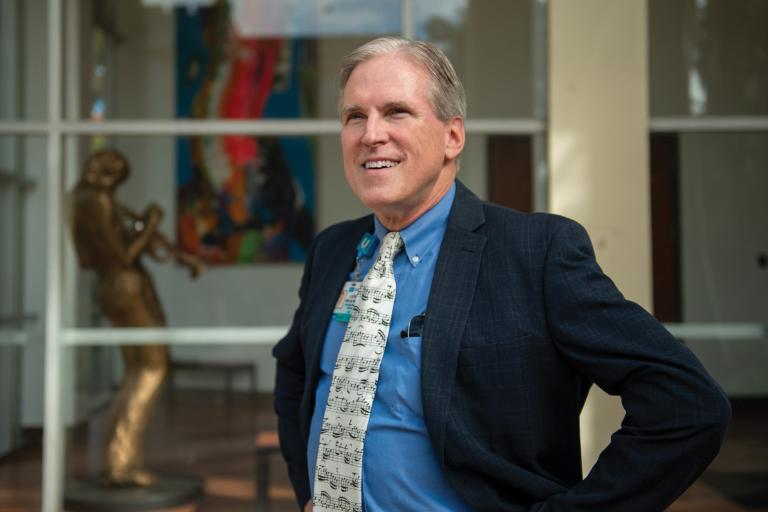How Music Resonates in the Brain
Scientists tune in to the brain’s emotional response to music
- 7 minute read
- Feature
Rehearsal of the Pasdeloup Orchestra at the Cirque d’Hiver by John Singer Sargent
The Hayden Collection—Charles Henry Hayden Fund

Rehearsal of the Pasdeloup Orchestra at the Cirque d’Hiver by John Singer Sargent
The Hayden Collection—Charles Henry Hayden Fund
Watching a movie can be a mesmerizing experience, not just for our eyes — but also for our ears. From The Lord of the Rings series and Schindler’s List to Interstellar and animated films like Mulan, movies can give rise to deep, complex emotions, thanks in large part to a key ingredient: music.
Take the Oscar-nominated film Maestro, about the life of American composer and conductor Leonard Bernstein, AB ’39. The most powerful scene in Maestro is arguably one in which there is no dialogue — only music.
Ensconced in a Gothic cathedral with an audience of extras, Bernstein, played by Bradley Cooper, directs a chorus of voices — the viewer’s entrée into the finale of Gustav Mahler’s Symphony No. 2. Two women’s voices emerge in a duet, lilting above a tapestry of strings. Trumpets pierce the air. A timpani rumbles as the chorus bursts into rapture. Finally, with church bells ringing, Bernstein brings the symphony to its epic conclusion.
Patrick Whelan, a Harvard Medical School lecturer in pediatrics, part-time, at Massachusetts General Hospital and instructor of the Harvard Extension School course Music and the Mind, observes that sitting in the audience for this type of piece can be a profound, prosocial experience.
“When you go into a church, the music takes over the mental faculties of all the people who are attending,” he says. “It puts everyone in the same emotional space.”
Our chordal roots
Why does music leave such an emotional impression on us in the first place? What is it about tones and timbres that, when organized in a precise manner, can make us swoon or sway?
Whelan believes the answer lies partly in evolutionary biology. The earliest mammals, most of them likely nocturnal, had to rely on their hearing and sense of smell as defensive mechanisms — they were hyperfocused, hyperattentive. According to Whelan, the modern experience of listening to live music can be viewed as a vestige of that primeval adaptation.
In a performance venue, “there’s an incredible complex sound signature all around you,” Whelan says. “The brain has to sift through all the ambient noise in a concert hall. It’s a much more primitive form of listening compared to a focused conversation.”
These acoustic cues — just like the crescendo of an approaching predator — travel through the ear and into the temporal lobe, which parses the soundscape, identifies sounds, and tags their components as familiar or unfamiliar.
The salience of these sounds — whether a person responds to them emotionally and motivationally — influences the autonomic nervous system (ANS), a network that controls certain involuntary processes like breathing and heart rate. The valence of the music, which signals whether the music feels positive, negative, or somewhere in between, influences the ANS, too. These factors are among the reasons why our heart rate goes up when we hear the infamous music from Jaws, or why experimental music or heavy metal might make us feel uncomfortable if we’re not used to it.

Music also lights up nearly all of the brain — including the hippocampus and amygdala, which activate emotional responses to music through memory; the limbic system, which governs pleasure, motivation, and reward; and the body’s motor system. This is why “it’s easy to tap your feet or clap your hands to musical rhythms,” says Andrew Budson, MD ’93, chief of cognitive and behavioral neurology at the Veterans Affairs Boston Healthcare System.
The brain’s elaborate receptivity to music means that “lots of different things are going on simultaneously,” Budson adds, so music “ends up being encoded as a rich experience.”
The intensity of musical tension
Brain activity in patients with certain disorders reveals unexpected connections with brain activity in people as they listen to music. Although models of obsessive-compulsive disorder pathophysiology are varied, evidence suggests that the condition is caused by faulty neural circuits in the orbitofrontal cortex (OFC), anterior cingulate cortex, caudate nucleus, and anterior thalamus. This dysfunctional neuronal “loop” has the OFC at its center. Sitting just above the eye sockets, the orbitofrontal cortex, involved in decision-making, is hyperactive both in people with OCD, and, intriguingly, in people as they listen to music.
Why would that be? One key way that music — particularly Western tonal music — generates emotions in the listener is through patterns of tension and resolution. The way such patterns play out, together with the way the music fulfills or violates our expectations, manipulates and reveals how the brain handles complex cognitive processes like prediction and anticipation.
According to Whelan, OCD can be described as a maladaptive stress assessment problem. In addition to lecturing at Mass General, Whelan has directed the multidisciplinary care for patients with PANDAS syndrome as an associate clinical professor of pediatrics in the Division of Pediatric Rheumatology at the University of California Los Angeles. PANDAS may be diagnosed when there is a strong association between Streptococcus infection, such as strep throat or scarlet fever, in children and the subsequent onset of OCD, tics, or other behavioral issues.
Individuals who are diagnosed with OCD are “incapable of stratifying the risks of the cues that are coming from their environment,” Whelan says. They excessively anticipate bad things happening and engage in obsessive thoughts or behaviors as an attempt to resolve — or prevent — those fears from becoming reality.
In other words, their orbitofrontal cortex runs on overdrive, just as it does when a person — with or without OCD — listens to music. But in the case of a person with OCD, hyperactivity in the OFC has a systemic, negative effect on the rest of the brain. Although the hyperactivity itself may not necessarily be the root cause of OCD symptoms, it’s certainly part of the OCD story, and the way music leverages buildup and release is a variation on that theme.
Music and healing
The effect of music on our brains has clinical implications as well. Growing evidence suggests, for example, that listening to Mozart’s Sonata for Two Pianos in D Major can reduce the frequency of seizures in some people with epilepsy.
Other conditions and diseases, ranging from Parkinson’s to depression to Alzheimer’s, could someday have therapeutic solutions derived from an understanding of music. For instance, by identifying the exact type of music able to provoke a particular cognitive, motor, or emotional response, there could be progress toward healing, improving, or compensating for disrupted brain function in various diseases. An increased understanding of brain mechanisms can facilitate this.
David Silbersweig, the Stanley Cobb Professor of Psychiatry at HMS and chair emeritus of the Department of Psychiatry at Brigham and Women’s Hospital, is interested in uncovering answers to these questions. A leader in functional neuroimaging research in psychiatry, he investigates how brain regions and networks function when we perceive, think, feel, and act.
We seem to be very much tuned for music.”
“It’s at the systems level with brain imaging that you can directly correlate mental states and brain states — and measure them.” Silbersweig says. “Neuroimaging provides a noninvasive way of correlating brain structural and functional abnormalities with specific aspects of music processing.”
For example, Silbersweig has seen people who survive stroke or tumors develop sensory amusia, a condition resulting from a lesion in the brain’s right superior temporal gyrus. Because this region is integral to recognizing disparate sounds as part of a cohesive work, patients with sensory amusia lose the ability to perceive or respond to music. While patients with this condition may not be able to revive damaged tissue, exposure to music itself can indirectly make up for the setback.
That’s because music’s immediacy — it unfolds in real time and captures our attention in a way that cannot be negotiated — makes it an ideal vehicle for creating specific experiences in the brain. With both immediate and long-term exposure to music, a person’s neurons will fire in new ways, helping to shape communication pathways over time.
Indeed, music is a potent tool for the future of precision medicine. As the scientific community continues to elucidate the emotional landscape of music, as well as how it differs from listener to listener, new methods for alleviating disease severity and improving overall well-being await both patients and otherwise healthy members of the general public.
As for Silbersweig, he and other colleagues in the field hope to continue weaving together what is known about the neural underpinnings of music into a more unified model, which Silbersweig thinks is an important — and meaningful — step.
“We seem to be very much tuned for music,” he says. “It resonates with us in some important way.”
Allison Eck is the executive communications manager in the HMS Office of Communications and External Relations.
Images: Museum of Fine Arts, Boston (Sargent painting); Erica Hou (Whelan); BWH/Mainframe Photographics (Silbersweig)
Continued funding uncertainty jeopardizes promising HMS research advances.